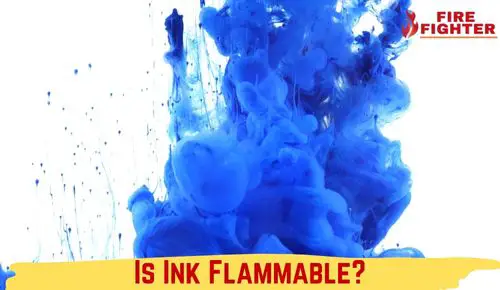Is Ink Flammable?
Ink has been used for centuries as a medium of expression, a communication tool and a way to capture memories.
But how flammable is this versatile substance? In this blog, we’ll explore the properties of ink, its chemical composition and the risks associated with its flammability.
Get ready to dive deep into the fascinating world of ink and discover the answer: Is ink flammable?
Contents
What Is Ink?
Ink is a liquid or pastes used to write or print on surfaces such as paper, cloth, or other materials. A mixture of dyes or pigments, a binder, and a solvent or carrier enables the ink to flow and adhere to the surface.
The composition of ink can vary widely depending on its intended use, such as writing, printing, or drawing. Inks can come in various colours, including black, blue, red, green, and many more.
Is Ink Flammable?
While the ink is not flammable, the paper it is printed on can be. The paper used in printing is usually made from wood pulp, which is flammable when exposed to an open flame.
This means that while ink itself is not flammable, it is possible for the paper it is printed on to catch fire.
Some types of ink may be more flammable than others. Certain types of ink, such as solvent-based inks, can contain small amounts of combustible materials.
These materials can ignite when exposed to an open flame, and the ink can burn along with the printed paper.

In general, ink is not flammable and should not be a cause for concern. However, keeping paper and other flammable materials away from open flames is always a good idea.
This will help minimize the fire risk starting in the home or workplace.
Is Burning Ink Toxic
Burning ink can be toxic as it releases harmful chemicals and fumes. When burned, ink can release chemicals such as carbon monoxide, nitrogen oxides, and volatile organic compounds (VOCs).
These chemicals can be harmful if inhaled and can cause irritation to the eyes, nose, throat, and lungs.
In addition, burning ink can also produce soot and particulate matter, which can aggravate respiratory problems and contribute to air pollution.
Therefore, burning ink or any other printed material is not recommended.
Burning ink, intentionally or accidentally, can produce toxic fumes that are harmful to inhale.
When burned, ink releases various chemicals and compounds, including carbon monoxide, nitrogen oxides, and polycyclic aromatic hydrocarbons (PAHs), which can be toxic to humans and animals.
Exposure to these fumes can cause various symptoms, including headaches, dizziness, nausea, and irritation of the eyes, nose, and throat.
Is Sharpie Ink Flammable?
The answer is yes. Sharpie ink is flammable in certain conditions. The ink is made up of several different ingredients, which can include flammable solvents. When exposed to high temperatures, these solvents will combust and cause the ink to burn.
While Sharpie ink can be flammable, it’s important to note that it does not ignite easily. For it to catch fire, it must reach temperatures over 700°F.
This is far higher than the average household fire – typically reaching temperatures around 1100°F.
It’s also important to note that Sharpie ink is not an accelerant – meaning it won’t cause a fire to spread faster than otherwise. If you were to drop it onto a burning surface, it would likely just put out the fire.
Sharpie ink is also very non-toxic, making it safe on various surfaces. It is safe to use in various art and craft projects as long as it is not exposed to extreme heat.
Is Ink Explosive
As for whether ink is explosive, the answer is generally no. Ink does not contain the type of explosive compounds, such as nitroglycerin or TNT, that are commonly associated with explosives.
However, certain types of ink can react with other chemicals or materials to produce heat or gas, which can be dangerous if not properly controlled.
When it comes to the flammability of ink, it depends on the specific type of ink.
Some types of ink, such as alcohol-based inks, are highly flammable and can ignite easily if exposed to heat, sparks, or flames.
These inks typically contain highly volatile solvents that can evaporate quickly, leaving behind a flammable residue.
Is Ink A Fire Hazard?
Ink can be a fire hazard under certain circumstances. The flammability of ink depends on its composition and the conditions in which it is stored or used.
Some inks contain highly flammable solvents, such as alcohol or acetone. If these solvents are exposed to a heat source or spark, they can ignite and cause a fire.
Moreover, the flash point of ink, which is the temperature at which it can ignite, varies depending on the type of ink.
Some inks have a low flash point, meaning they can easily ignite at room temperature, while others have a higher flash point, meaning they require higher temperatures to ignite.
Ink can also be a fire hazard in the printing process. Printers use heat to fuse the ink onto paper; if the ink or the paper is exposed to too much heat, it can catch fire.
Additionally, if the printer is not properly maintained, it can cause an electrical fire.
What Happens If You Burn Ink
When ink is burned, it releases a variety of toxins into the air. The most common toxins released are nitrogen, sulfur, carbon monoxide, and formaldehyde.
These toxins can be extremely hazardous to breathe in, as they may cause eye, nose and throat irritation, headaches, and nausea, and even lead to long-term health problems such as cancer.
In addition to the toxins released when ink is burned, the ink itself can also be hazardous to your health. The burning of ink produces a variety of particulate matter, which can irritate your respiratory system.
This particulate matter can also contain heavy metals and other harmful chemicals.
The burning of ink can also be a fire hazard. Ink is highly flammable and can ignite quickly when heated. This is why it is important to never burn ink near an open flame or another heat source.
Burning ink can also cause permanent damage to the surface it is burned. Ink can leave behind a stained or discoloured residue on surfaces such as paper, clothing, and skin. This can be difficult to remove and in some cases, may even be impossible.
Is Ink Hazardous
Ink can be considered hazardous depending on the type of ink and its intended use.
Certain types of ink can contain toxic chemicals that pose health risks to humans and the environment, especially if not handled properly.
For example, some types of ink used in printers, such as toner ink, can contain volatile organic compounds (VOCs) that can be harmful if inhaled.
Additionally, some inks used for tattoos and permanent makeup can contain heavy metals such as lead, mercury, and cadmium, which can cause skin irritation, allergic reactions, and other health problems.
It is important to read any ink product’s labels and safety data sheets and follow proper handling and disposal procedures to avoid potential hazards.
Proper ventilation and personal protective equipment should also be used when necessary.
Common Types Of Ink
There are many different types of ink, each with its specific properties and uses. Some of the most common types of ink include:
Water-based ink: This type of ink uses water as the solvent, making it easy to clean up and non-toxic. It is commonly used in fountain pens, markers, and some printers.
Oil-based ink: Oil-based ink uses oil as the solvent, making it more permanent and resistant to smudging. It is commonly used in ballpoint pens, printing presses, and screen printing.
Solvent-based ink: Solvent-based ink uses chemicals as the solvent, making it fast-drying and waterproof. It is commonly used in industrial printing, such as packaging or labels.
UV-curable ink: This type of ink is cured by exposure to ultraviolet light, making it fast-drying and resistant to fading and smudging. It is commonly used in high-quality printing applications, such as on signs and displays.
Digital ink: Digital ink is used in electronic devices such as printers and e-readers. It is often composed of tiny particles that are precisely deposited onto a surface to create text or images.
Is Fountain Pen Ink Flammable?
The simple answer to this question is no. Fountain pen ink is not flammable, so you can rest assured that your ink won’t catch on fire.
This is because most fountain pen inks are made up of water-based dyes and pigments. These are non-flammable, so they won’t ignite even when exposed to a flame.
However, it’s important to note that some fountain pen inks contain flammable solvents and dyes. It’s always a good idea to check the label of your ink before purchasing it to make sure that it is safe to use.
It’s also important to be mindful of where you store your ink. While fountain pen ink is not flammable, it’s still best to keep it away from any open flames or sources of heat. This will help to ensure that it doesn’t accidentally ignite.
Finally, practising good safety measures when working with fountain pen ink is always a good idea. While it’s not flammable, the ink can still irritate if it comes in contact with the skin or eyes.
Therefore, it’s best to use caution and wear protective goggles when working with ink to avoid potential complications.
Is Tattoo Ink Flammable?
Tattoo ink is a type of ink that is specifically designed to be used for tattooing on human skin. It comprises various ingredients, including pigments, carriers, and sometimes additives.
While tattoo ink is not highly flammable, it can be considered a fire hazard under certain conditions.
Most tattoo ink is water-based, meaning it is not likely to catch fire easily. However, some inks may contain alcohol or other flammable solvents that could increase the flammability of the ink.
Additionally, some tattoo artists use heat or open flames during tattooing, which could increase the fire risk.

Tattoo artists need to take precautions to prevent fires when working with ink. This may include using non-flammable ink, avoiding open flames during tattooing, and having fire extinguishing equipment readily available in an emergency.
Is Printer Ink Flammable
Printer ink can be flammable, but it depends on the type of ink and its components.
In general, water-based inks that are commonly used in inkjet printers are not flammable. They are made up of a mixture of water, dyes or pigments, and a small amount of alcohol or glycol as a drying agent. These inks are considered non-flammable and non-combustible.
On the other hand, solvent-based inks used in some types of printers, such as large-format printers, are flammable. Solvent-based inks comprise volatile organic compounds (VOCs) that can ignite easily and release harmful fumes when burned.
Handling and storing printer ink properly is important to avoid any potential fire hazards. This includes keeping it away from sources of heat, sparks, or flames and storing it in a well-ventilated area.
Following the manufacturer’s instructions when disposing of ink cartridges and other ink-related materials is also important.
Conclusion
Based on the information available, it can be concluded that not all types of ink are flammable. However, some types of ink, such as those containing organic solvents or other flammable components, can be flammable and may pose a fire hazard if not handled properly.
It is essential to read the label and safety data sheet of ink products before use and follow appropriate safety precautions to avoid accidents.
In general, handling any potentially hazardous materials, including ink, with caution and following appropriate safety measures is always recommended.

Hi, I m Aaron Smith, a firefighter, and creator of Firefighterline.com, a website that provides top-notch training courses for firefighting organizations. After completing my studies, I quickly rose through the fire service ranks, eventually becoming Captain at one of the busiest fire departments in the state.

